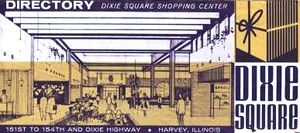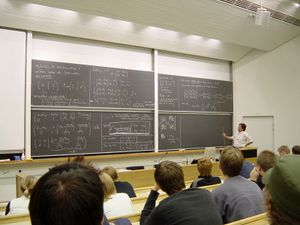Virtually Virtual Reality
Virtually virtual reality (abbreviated VVR) describes a set of technologies which can be used to virtually simulate virtual environments. VVR has been deployed extensively on the world wide web for commercial, entertainment, cultural, and educational purposes.
VVR Technologies and Principles[edit | edit source]
VVR utilizes quantum computing and physics standard modeling to create an immersive environment. These technologies are combined with virtually simulated neural nets to create fully interactive avatars (called people) within these environments. By utilizing PPP (photon particle protocol) and HFP (Higgs field protocol) over the internet, a VVR world can be transmitted in full to an end user anywhere in the world. VVR implementations incorporate virtually artificial visual, aural, olfactory, and tactile stimuli to create a remarkable level of immersion and interactivity for the end user.
Early Implementations of VVR[edit | edit source]
The earliest VVR environment was developed at Argonne National Laboratory in 1965 and was demonstrated to the public in 1966 in nearby Harvey, Illinois. This first VVR environment was dubbed Dixie Square Shopping Center. Users within this environment could interact with each other using IVC (interactive vocal chat), a precursor to IRC. Users could also enter virtually virtual store environments, where they could find and purchase products which would then be delivered immediately. Inventory data was presented in real-time; merchants would see virtually virtual representations of merchandise that was in stock. Dixie Square Shopping Center represented an early commercial success of VVR technologies.
Other early VVR experiments included Fallbrook Mall of West Hills, California, developed by researchers at Caltech in 1968; and Mohawk Mall, located in Schenectady, New York, developed by researchers at Stony Brook University in 1970.
Applications of VVR[edit | edit source]
Education[edit | edit source]
VVR technology became popular with the widespread adoption of the internet. One of its first applications was in education. Virtually virtual campuses came to be used by thousands of students. This type of education came to be called zero-distance education. On a virtually virtual campus, a directory of academic subjects is presented as a set of virtually virtual buildings. To study a subject, a student need only enter one of the buildings (after entering the virtually virtual registrar’s office where tuition, used to maintain the school’s VVR server, is paid).
Within each virtually virtual building, a student can encounter teaching avatars. In virtually virtual lecture halls, students can interact with each other and the teaching avatar using natural spoken language. Some schools also allow students to interact individually with a teaching avatar. During these virtually virtual sessions, or office hours, students can enjoy a personal educational experience.
Commerce[edit | edit source]
VVR vendors have created appealing VVR spaces designed to sell a wide range of goods and services. In virtually virtual stores, merchants keep track of inventory in real time using actual visual representations of goods. Customers receive multisensory virtually virtual simulations of products and can receive information from sales avatars. Many customers prefer the personal interaction made possible in VVR stores.
One of the first major vendors in VVR was Wal-Mart. Wal-Mart’s VVR experience, with its large number of products available and instant delivery, allowed Wal-Mart to make a profit of $8.4 billion in 2004.
Entertainment[edit | edit source]

VVR has also proven to be popular in the entertainment industry. The large bandwidth provided by quantum computing and photon particle protocol allows for compelling interactive experiences. Many enjoy purchasing virtually virtual pets in VVR. These virtually virtual pets are fed virtually virtual food and play with virtually virtual toys (which both may be purchased with additional virtually virtual money). Virtually virtual dogs need to be virtually virtually walked at regular times at each day. Virtually virtual pets can die if they are denied virtually virtual care; however, should this happen, a new virtually virtual pet can be purchased with little difficulty.
Others enjoy virtually virtual cinema. Virtually virtual cinema not only virtually simulates a movie, but also an audience, popcorn, and the long lines that are part of the movie-going experience. Comedy clubs, gambling, and interactive chat rooms are extremely popular as VVR experiences.
VVR Communities[edit | edit source]
VVR communities started to become popular in 1995. Among the earliest VVR communities were Quakers.org and Amish.org. In these virtually virtual communities, clusters of commerce sites, educational sites, and other special interest sites are brought together in a single virtually virtual location. These sites are hypolinked using virtually virtual roads and virtually virtual sidewalks. Users can travel within a VVR community using virtually virtual walking or virtually virtual cars. Within a VVR community, users can communicate with the avatars of other users, sales avatars, and adminstrator avatars using natural language and gestures. Many users join VVR communities for the rich types of social interactions which are available within.
In 2002, the IEEE released a set of standards that allowed VVR communities to be linked together. Today, millions of people daily use virtually virtual airplanes and virtually virtual trains to travel between the wide range of VVR communities. This world wide web of VVR communities promises to have a significant impact on the future development of technology and culture.
A VVR Experience[edit | edit source]
Thanks to the administrators of Uncyclopedia (and in particular the hard work of Carlb, Elvis, and Rcmurphy), the Uncylopedia now hosts a small VVR server. By downloading a VVRML plugin, you can experience VVR for yourself.
VVR Plugin[edit | edit source]
The VVRML plugin requires runs on any Windows system or better (better includes Mac OS X and Linux). It requires a G3 or 386 processor (or better). Click on the link below to download the VVRML plugin. Once the plugin has been downloaded, initialized, and calibrated, you will be returned to a VVR representation of this page.
VVR Walkthrough[edit | edit source]
Using your IP address, extrapolations from collected data of quantum effects of the immediate environment on the CPU of your computer, and Google, the VVR server will create a representation of your environs and abode. The Uncyclopedia VVR server will send commands to your computer that will generate a special pattern on your monitor. This pattern will create interference patterns of photons and immerse you in a holographic image. The first hologram that you see will look like the area around your computer. This is your home portal. The VVR representation of this page will look like an Uncyclopedia entry on your virtually virtual monitor.
- In the VVR representation of your kitchen, find a large sharp knife. You will need the knife later.
- Find a copy of the Yellow Pages. The VVR server will list some of the immediate hypolinks available. Find a listing of department stores in your virtually virtual community.
- Choose a method to get to a virtually virtual department store. You may choose virtually virtual walking, virtually virtual driving, or a virtually virtual taxi.
- Look at the sky. The Uncyclopedia VVR server uses real-time data to render the sky according to the time of day.
- The virtually virtual store will maintain real-time data on inventory. You may ask the sales avatars for information using a natural language interface.
- To complete a conversation, run the knife through the avatar. This gesture indicates that you want to close the chat. You can use this same gesture to close chats with other users and avatars you encounter.
- Once you have completed your desired purchases, return to your home portal.
- Close your eyes, click your heels together three times, and repeat the phrase “There is no place like home.” The VVR server will recognize this gesture and exit you back to your web browser.
VVR Issues and Controversies[edit | edit source]

The proliferation of malware on VVR sites has been of great concern. As of 2005, over 4 million types of VVR viruses had been detected. Entertainment sites in particular have tended to be a cause of concern with respect to viruses. Spyware has also been problematic on VVR sites.
VVR has also been the subject of many legal controversies. National governments have imposed their own laws and regulations upon visitors to VVR sites hosted within their jurisdictions.
The long range impact of VVR on society has been of a concern to many sociologists. Many youth show signs of “addiction” to VVR, spending many hours each day on virtually virtual reality sites. Some psychologists suggest that with the prevalence of VVR, certain people may become unable to distinguish between VVR and reality. Such people may engage in antisocial and psychopathic behavior.
Future Prospects for VVR[edit | edit source]
Already, VVR has had a large impact on the social fabric of modern society. Elements of VVR, such as virtually virtual hip hop, have entered the popular culture. In 2004, VVR communities had a large impact upon the Presidential election in the United States. As the number of VVR users increase, society and culture and certain to undergo small and large changes.
See Also[edit | edit source]
- The Matrix
- Virtual Realty
- Virtuous Reality
- Vitreous Reality
- Vitriol Reality
- Actual Reality
- Virtual Virtual Reality Uncyclopedia Entry


